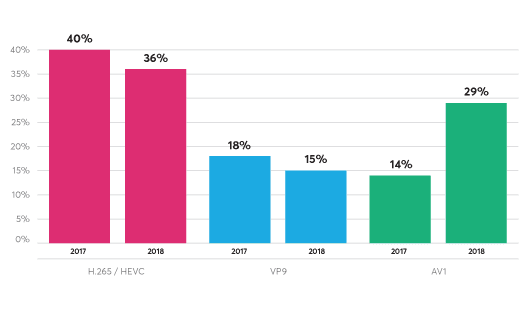H.264 Dominates Developer Video Encoding Use, H.265 On The Rise
PALO ALTO, CA.—A new report from online video technology provider Bitmovin finds that in 2018 the H.264/AVC video codec has continued to dominate video encoding used by developers around the world while the use of H.265/HEVC has grown significantly from 2017 to the present.
In its second year, the “Video Developer Report 2018” draws on the responses of 456 survey developer submissions from more than 67 countries to paint a picture of the current state of video streaming technology and what will be important over the next year.
Besides video codec technology, the report presents findings on other key streaming technology, such as streaming formats, software vs. hardware encoding, audio-video format delivery popularity, native playback and OTT streaming device technology, ad architecture and other topics.
[Read: Can Video Compression Tame The Internet?]
As in 2017, the results reveal that nine out of 10 developers continue to use H.264/AVC, while the percentage saying they are using H.265/HEVC has climbed from 28 percent in 2017 to 42 percent this year. VP9 saw a slight 1 percentage point uptick in the 2018 total to 11 percent, and AV1 remained flat at 6 percent.
Future plans for codec use paint a different picture. In 2017, 40 percent of developers said they planned to use H.265/HEVC in the 12 months, while 36 percent said the same this year; 18 percent said their plans called for using VP9 last year, while 15 percent said they did this year.
AV1 recorded the biggest increase with 14 percent in 2017 saying the codec would be used in 12 months, while 29 percent said so in 2018.
Get the TV Tech Newsletter
The professional video industry's #1 source for news, trends and product and tech information. Sign up below.

Other highlights of the report include: 82 percent saying they are using the HLS streaming format, while 61 percent use MPEG-DASH; 43 percent saying they use hardware encoders, while 54 percent use on-prem software encoders, and 38 percent use a software encoder in the cloud; and 52 percent saying they use client-side ad insertion, 44 percent saying they use server-side ad insertion and 25 percent saying they use dynamic ad replacement.
The free report is available online from Bitmovin. Registration is required.
Phil Kurz is a contributing editor to TV Tech. He has written about TV and video technology for more than 30 years and served as editor of three leading industry magazines. He earned a Bachelor of Journalism and a Master’s Degree in Journalism from the University of Missouri-Columbia School of Journalism.

